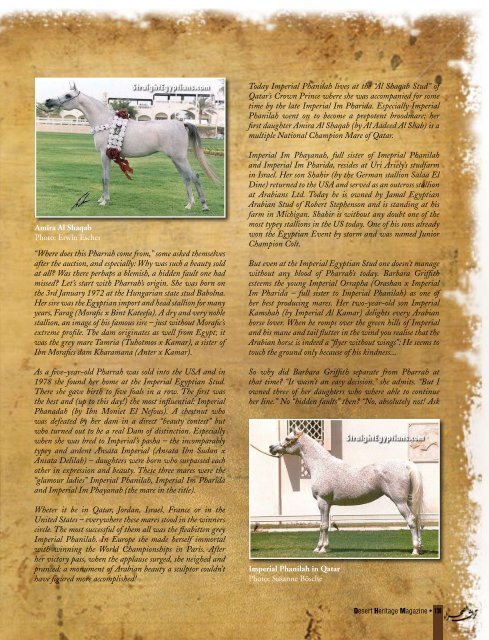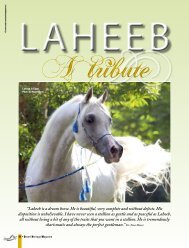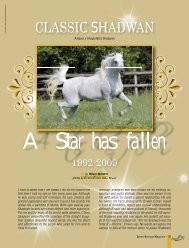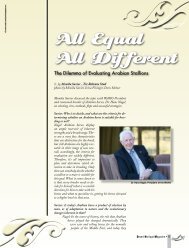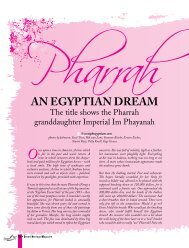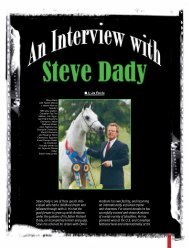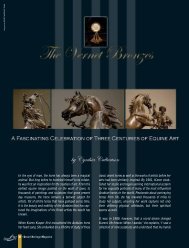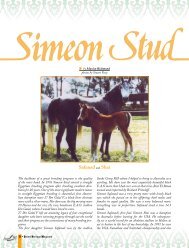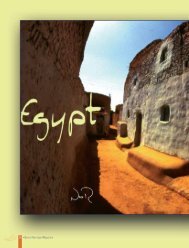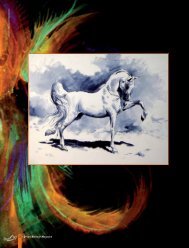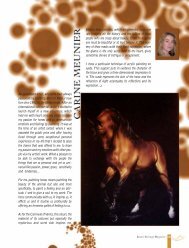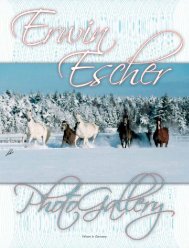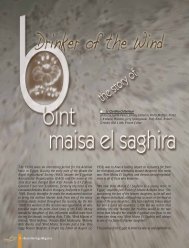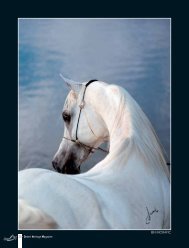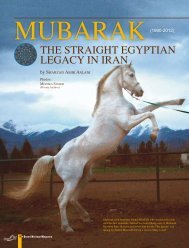Pharrah - Desertheritagemagazine.com desert heritage magazine
Pharrah - Desertheritagemagazine.com desert heritage magazine
Pharrah - Desertheritagemagazine.com desert heritage magazine
You also want an ePaper? Increase the reach of your titles
YUMPU automatically turns print PDFs into web optimized ePapers that Google loves.
Amira Al Shaqab<br />
Photo: Erwin Escher<br />
“Where does this <strong>Pharrah</strong> <strong>com</strong>e from,” some asked themselves<br />
after the auction, and especially: Why was such a beauty sold<br />
at all? Was there perhaps a blemish, a hidden fault one had<br />
missed? Let’s start with <strong>Pharrah</strong>’s origin. She was born on<br />
the 3rd January 1972 at the Hungarian state stud Babolna.<br />
Her sire was the Egyptian import and head stallion for many<br />
years, Farag (Morafic x Bint Kateefa). A dry and very noble<br />
stallion, an image of his famous sire – just without Morafic’s<br />
extreme profile. The dam originates as well from Egypt; it<br />
was the grey mare Tamria (Tuhotmos x Kamar), a sister of<br />
Ibn Morafics dam Kharamana (Anter x Kamar).<br />
As a five-year-old <strong>Pharrah</strong> was sold into the USA and in<br />
1978 she found her home at the Imperial Egyptian Stud.<br />
There she gave birth to five foals in a row. The first was<br />
the best and (up to this day!) the most influential: Imperial<br />
Phanadah (by Ibn Moniet El Nefous). A chestnut who<br />
was defeated by her dam in a direct “beauty contest” but<br />
who turned out to be a real Dam of distinction. Especially<br />
when she was bred to Imperial’s pasha – the in<strong>com</strong>parably<br />
typey and ardent Ansata Imperial (Ansata Ibn Sudan x<br />
Ansata Delilah) – daughters were born who surpassed each<br />
other in expression and beauty. These three mares were the<br />
“glamour ladies” Imperial Phanilah, Imperial Im Pharida<br />
and Imperial Im Phayanah (the mare in the title).<br />
Wheter it be in Qatar, Jordan, Israel, France or in the<br />
United States – everywhere these mares stood in the winners<br />
circle. The most successful of them all was the fleabitten grey<br />
Imperial Phanilah. In Europe she made herself immortal<br />
with winning the World Championships in Paris. After<br />
her victory pass, when the applause surged, she neighed and<br />
pranced: a monument of Arabian beauty a sculptor couldn’t<br />
have figured more ac<strong>com</strong>plished!<br />
Today Imperial Phanilah lives at the “Al Shaqab Stud” of<br />
Qatar’s Crown Prince where she was ac<strong>com</strong>panied for some<br />
time by the late Imperial Im Pharida. Especially Imperial<br />
Phanilah went on to be<strong>com</strong>e a prepotent broodmare; her<br />
first daughter Amira Al Shaqab (by Al Aadeed Al Shab) is a<br />
multiple National Champion Mare of Qatar.<br />
Imperial Im Phayanah, full sister of Imeprial Phanilah<br />
and Imperial Im Pharida, resides at Uri Ariely’s studfarm<br />
in Israel. Her son Shahir (by the German stallion Salaa El<br />
Dine) returned to the USA and served as an outcross stallion<br />
at Arabians Ltd. Today he is owned by Jamal Egyptian<br />
Arabian Stud of Robert Stephenson and is standing at his<br />
farm in Michigan. Shahir is without any doubt one of the<br />
most typey stallions in the US today. One of his sons already<br />
won the Egyptian Event by storm and was named Junior<br />
Champion Colt.<br />
But even at the Imperial Egyptian Stud one doesn’t manage<br />
without any blood of <strong>Pharrah</strong>’s today. Barbara Griffith<br />
esteems the young Imperial Orrapha (Orashan x Imperial<br />
Im Pharida – full sister to Imperial Phanilah) as one of<br />
her best producing mares. Her two-year-old son Imperial<br />
Kamshah (by Imperial Al Kamar) delights every Arabian<br />
horse lover. When he romps over the green hills of Imperial<br />
and his mane and tail flutter in the wind you realise that the<br />
Arabian horse is indeed a “flyer without wings”: He seems to<br />
touch the ground only because of his kindness...<br />
So why did Barbara Griffith separate from <strong>Pharrah</strong> at<br />
that time? “It wasn’t an easy decision,” she admits. “But I<br />
owned three of her daughters who where able to continue<br />
her line.” No “hidden faults” then? “No, absolutely not! Ask<br />
Imperial Phanilah in Qatar<br />
Photo: Susanne Bösche<br />
Desert Heritage Magazine • 139


